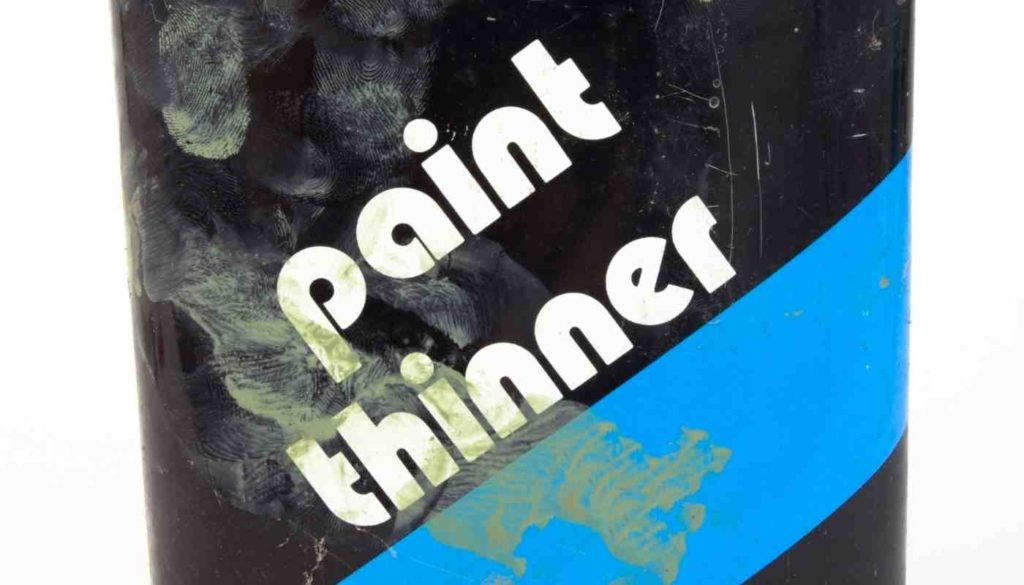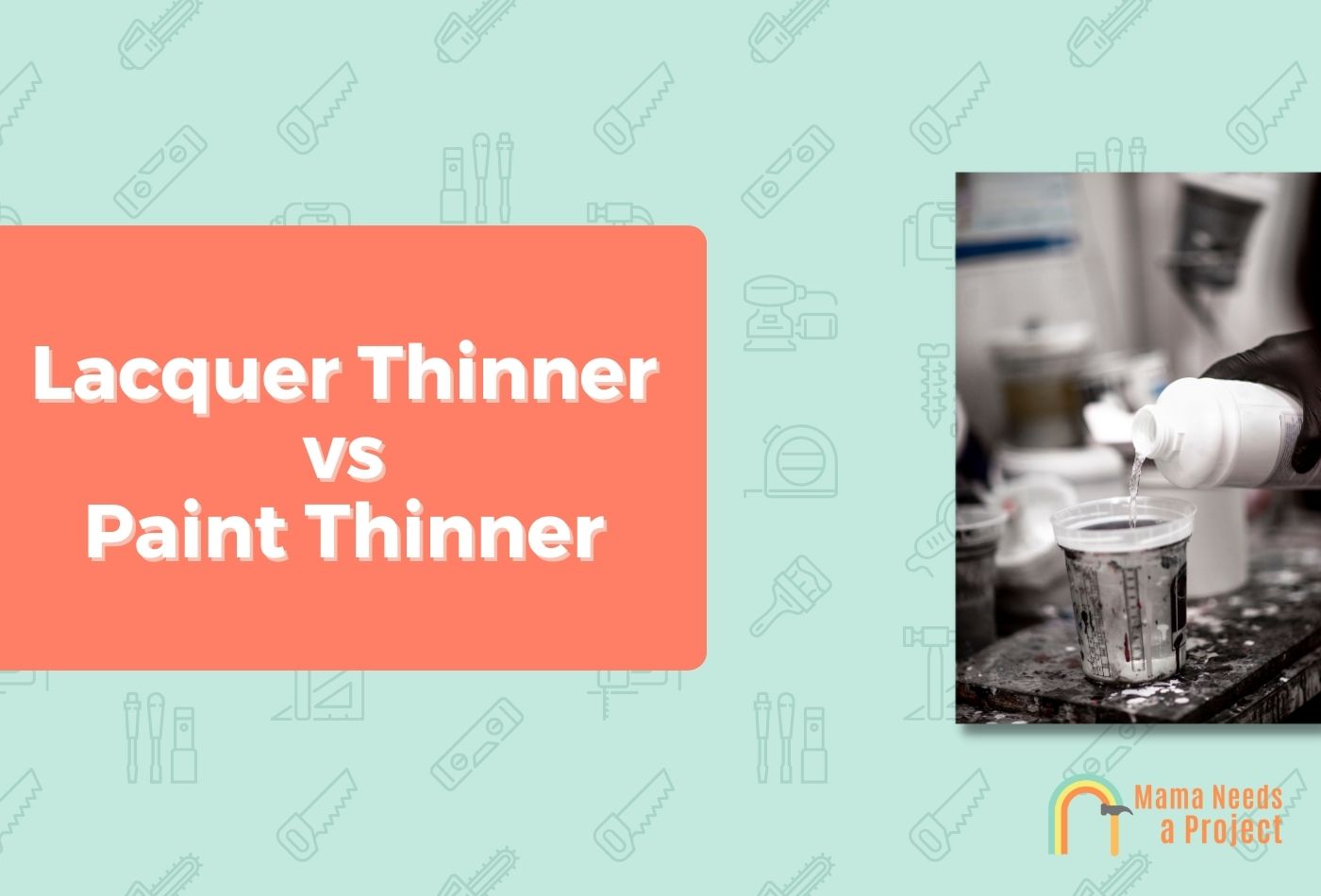Lacquer Thinner vs Paint Thinner: Which is Better? (Ultimate Guide)
Lacquer thinners and paint thinners are really useful (and sometimes stinky!) chemical solvents used to thin different lacquers, epoxies, and oil-based paints.
These substances really do come in handy when you’re trying to get hardened paint off certain surfaces or make viscous lacquers easier to work with.
The trouble is, while lacquer and paint thinners share many similar properties, they serve slightly different purposes.
It’s important to understand the key differences between lacquer thinner vs paint thinner, so you know exactly which one to reach for when you need one. Let’s get into that now.
- Lacquer thinner is fast-acting, highly flammable and aggressive, and more expensive than paint thinner.
- Lacquer thinner is used for cleaning lacquer off tools, as a gun cleaner solvent, improving spraying lacquer flow, and removing oil based paint.
- Paint thinner is used for the cleaning and thinning of oil-based paints, and to clean brushes. It also allows oil-based paints to move through paint sprayers more easily.
What Is Paint Thinner?

Paint thinner is a liquid solvent used to thin oil-based paints. But thinning the viscosity of paint so that it sprays easier from a spray gun isn’t the only way to use it.
Paint thinner also works on cleaning spilled paint off various surfaces, like furniture, paint brushes, flooring, and even skin (not recommended for those with sensitive skin).
Paint thinner consists of various volatile organic compounds (VOCs), but generally the primary ingredient is mineral spirits.
You might also be familiar with other types, like turpentine, acetone, and toluene.
It’s important to note that the VOC fumes from paint thinner can be hazardous to your health after long periods of exposure, so make sure to use it in a well ventilated area.
What is Lacquer Thinner?
Lacquer is a liquid thinner and solvent used to clean up and thin lacquer based paints. As opposed to paint thinner, lacquer thinner is made up of multiple solvents.
It works very fast and powerfully to thin and separate the molecules in lacquer based paints.
Lacquer itself can be really thick, making it challenging to evenly spray or brush onto a surface. The results may come out bumpy or pitted. By mixing lacquer thinner in with the lacquer, you can enjoy a much smoother finish.
Lacquer thinner also dries in a matter of minutes.
Lacquer Thinner Vs Paint Thinner: The Major Differences
Let’s discuss the four main characteristics that separate paint thinner from lacquer thinner: the ingredients, the VOC levels, the strength, and the usage.
Ingredients
While these two thinners have generally the same overall use, they don’t share the same formulation.
Many lacquer thinners are made of more ingredients than paint thinners, spanning from acetone and methanol to hydrotreated light distillate.
Because of the VOCs, lacquer thinners are considered hazardous waste.
Paint thinner’s primary ingredient is usually mineral spirits, but may also be combined with chemicals like mineral turpentine, MEK, xylene, and others.
Because of the VOCs, paint thinner is considered hazardous waste.
Check out this guide on paint thinner vs acetone to find out which is better for your needs!
VOC Levels & Flammability
In general, lacquer thinner has fewer VOCs than paint thinner.
But this doesn’t mean lacquer thinner is less “volatile.” In fact, lacquer thinner is highly flammable, more so than paint thinner.
Standard paint thinner contains more VOCs than lacquer thinner, but it’s less flammable than lacquer thinner.
If you’re concerned about the high VOC levels in paint thinner, you can purchase a non-toxic alternative like Klean-Strip Green Paint Thinner.
Strength & Evaporation
When it comes to thinning and cleaning power, lacquer thinner is the clear winner.
Composed of strong chemical ingredients, lacquer thinner can break apart the molecules in lacquer in seconds.
It also evaporates and dries within just a few minutes. This means that while you may have to worry about protecting your respiratory health from the bad odor, you can complete your job nice and fast.
In a pinch, lacquer thinner is so effective that it can even remove acrylic paint from wood. Just try to avoid using it too often for anything but its primary purpose.
Paint thinner is also a strong solvent, capable of stripping heavy oil-based paints off caked-on paint brushes and metal tools. But it doesn’t have such a strong odor, and is slower-acting than lacquer thinner.
Usage
As mentioned, paint thinner and lacquer usage differs. While it’s true that both lacquer thinner and paint thinner are solvents used on oily surfaces, that’s where the similarities mostly end.
Lacquer thinner is designed for softening dried and cured lacquers. It’s much stronger than paint thinner, and can even erode rubber and plastic.
Mineral spirits paint thinner is used to remove paint or thin oil based paint on different surfaces.
It can dissolve enamel paints and thin out the viscosity of thicker paints. It’s safe to use on rubbers and plastics.
Here’s a great video explaining the differences between many popular solvents!
FAQs
What are the three types of thinner?
Three types of thinner that remove paint from plastic or cement surfaces are lacquer thinner, acetone, and paint thinner mineral spirits.
Pure mineral spirits is a core ingredient in many paint thinners, but turpentine and denatured alcohol can also be the primary ingredient.
Is lacquer thinner just acetone?
Acetone is often used as a solvent to thin lacquers and paints, but it doesn’t have the same chemical composition as lacquer thinners.
It evaporates even more rapidly than lacquer thinner, and is a more appropriate choice for dissolving paint rather than lacquer.
Acetone may not always be the best choice when you need to thin lacquer. It’s better to select lacquer thinners for the job.
Is lacquer thinner the same as paint thinner?
No, lacquer thinner is not the same as paint thinner. While both solvents may share some similar ingredients, they also contain different chemicals.
Lacquer thinners are formulated with two or more solvents, and are more potent than paint thinners. They’re most effective at thinning lacquer. Lacquer thinners also have different safety and environmental concerns than paint thinner.
Lacquer thinners aren’t rubber or plastic safe, and are more flammable. On the other hand, paint thinners can clean surfaces without ruining the surface beneath. They’re also great for cleaning brushes and cleaning oil based paints or surfaces an oily texture.
Final Thoughts
So, what’s the difference between lacquer thinner and paint thinner?
Paint thinner works best for cleaning and thinning oil paints.
And lacquer thinner is ideal for cleaning lacquer off surfaces, and thinning it out for an easier application.
Just remember: lacquer thinner is very potent, with a powerful odor and high flammability.
Make sure to practice safe usage by wearing personal safety gear, minimizing contact with your skin, and using them in a well ventilated area.

Jessica Vaillancourt is a freelance writer and blogger obsessed with the Travel, Wellness, and Personal Development industries.
She has 5+ years of experience helping human-first agencies, global companies, and entrepreneurs crush their content marketing goals, and serve more people. Jessica’s work has appeared on leading websites like UpgradedHome.com, BetterHelp.com, and TheDiaryofaNomad.com.
Today, her sole focus (besides finding the world’s best coffee shop) is writing to serve humans, and slow traveling abroad to expand her mind. You can get to know her work at JessAnneWriting.com.

